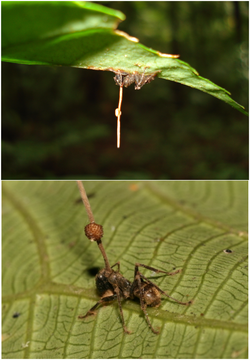| Ophiocordycipitaceae Temporal range: Middle Cretaceous - Recent, [1] | |
|---|---|
 | |
| Dead ants infected with Ophiocordyceps unilateralis | |
| Scientific classification | |
| Domain: | Eukaryota |
| Kingdom: | Fungi |
| Division: | Ascomycota |
| Class: | Sordariomycetes |
| Order: | Hypocreales |
| Family: | Ophiocordycipitaceae G.H.Sung, J.M.Sung, Hywel-Jones & Spatafora (2007) |
| Type genus | |
| Ophiocordyceps Petch (1931) | |
Ophiocordycipitaceae is a family of parasitic fungi in the phylum Ascomycota, class Sordariomycetes. It was created in 2007 to resolve the paraphyly of Calvicipitaceae. [2] It was updated in 2020. [3]